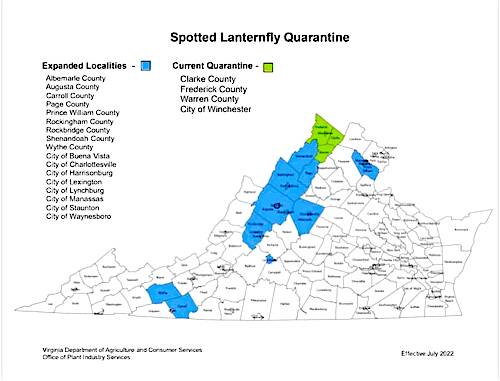
~ Press release issued by Virginia Farm Bureau Federation
RICHMOND, June 22 — A species of invasive pests damaging vineyards in a few northern Virginia counties is headed south, and state officials are taking action to slow the spread.
With no natural enemies in the U.S., spotted lanternflies, Lycorma delicatula, can cause extensive damage to vines, crops and trees. Virginia’s Spotted Lanternfly Quarantine currently includes the City of Winchester and the counties of Clarke, Warren and Frederick.
“Together, pesticide treatments and the Spotted Lanternfly Quarantine have slowed the spread of this invasive pest,” said David Gianino, program manager for the Virginia Department of Agriculture and Consumer Services Office of Plant Industry Services. “However, surveys conducted by VDACS indicate that spotted lanternfly populations have now become established in other cities and counties.”
In early July, the quarantine zone will be expanded to the cities of Buena Vista, Charlottesville, Harrisonburg, Lexington, Lynchburg, Manassas, Staunton and Waynesboro, and Albemarle, Augusta, Carroll, Page, Prince William, Rockbridge, Rockingham, Shenandoah and Wythe counties.
“Beyond direct damage to crops, the lanternfly also poses a risk to any business reliant on import and export of goods between states, as other states consider quarantines to prevent the spread of the invasive species,” said Ben Rowe, Virginia Farm Bureau Federation district field services director.
The spotted lanternfly has been traced back to a cargo load of landscaping stone shipped to Pennsylvania from China in 2014. The insects have been prolific in Frederick County since 2018, said Virginia Cooperative Extension agent Mark Sutphin.
Spotted lanternflies amass in high numbers and drink vast amounts of sap, draining a host plant of resources, Sutphin explained. They excrete a sugary substance called honeydew that encourages the growth of black sooty mold and blocks photosynthesis in understory leaves, further reducing plant capacity.
While the pest feeds on over 100 plant species, wine grapes are the crop of greatest concern in Virginia.
“The vines get stressed, which reduces hardiness going into the winter, and can lead to complete death,” he said.
Quarantines and insecticides are somewhat effective.
“But there’s not a silver bullet out there unfortunately,” Sutphin continued. “The goal is to give businesses and growers as much time as possible to allow science to catch up, and maybe a biological control will emerge.”
VDACS officials say regulations are necessary to reduce further spread. Regulated items must be free of spotted lanternflies or egg masses prior to transport outside a quarantine area. A permit allowing businesses to conduct self-inspections of regulated items can be obtained through VDACS after completing online training.
Visit bit.ly/3zES5ke for information on the Spotted Lanternfly Quarantine, including permitting instructions and a list of regulated items.
•••
RELATED ARTICLES
Virginia Tech researchers working to develop methods to measure farm-to-fork food loss
Study examines meat retailing opportunities for farmers
Future of farming in Page, a work in progress
Extension Office seeks vendors for weekly farmers market at PMH June through October



Be the first to comment